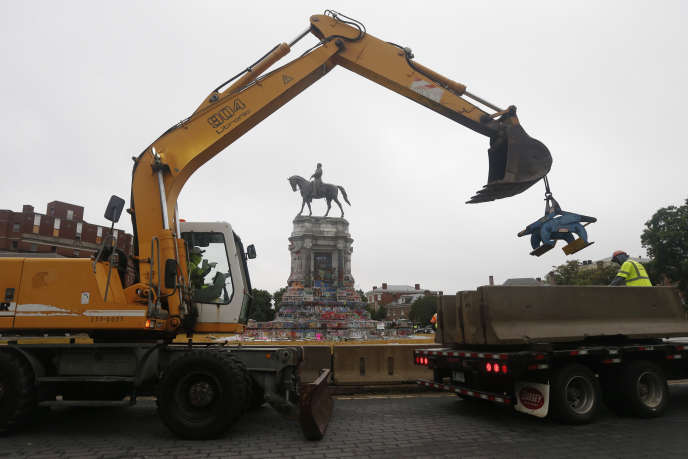If Monument Avenue, in Richmond, is not the most beautiful avenue in the world, it is in any case one of the most beautiful in Virginia and probably in the United States. It is there, in the heart of the former capital of the Confederate States, which has become a place of pilgrimage of southern memory, that six statues stand, including five, installed between 1890 and 1929, are disputed.
There is that of Jefferson Davis, the president of the Confederate States, that of two southern generals J. E. B. Stuart and Stonewall Jackson, that of the sailor and oceanographer of the southern navy Matthew Fontaine Maury. And… that of the famous tennis player Arthur Ashe, who died in 1993 and comes from Richmond, settled in 1996 – without any connection with the others. But it is above all that of Robert E. Lee, the general-in-chief of the armies of the slave states during the American Civil War and southern icon, which draws attention.
Page Contents
"Motionless ghosts that haunt the South"
If these statues have already aroused reluctance as early as the 1890s, as the American Civil War Museum recalls, they have once again been, since the mid-2010s, at the heart of heated debates. "Monuments were targeted as early as June 2015 when several of them were tagged with the slogan Black Lives Matter", recalls Andrew Houck, doctoral candidate in American history at Paris-Nanterre University and specialist in the American Civil War.
The question of their continued existence was revived in 2017, when America was shaken by the massacre perpetrated in a church frequented by African Americans in Charleston, South Carolina. These Confederate monuments then became a subject of controversy – "Motionless ghosts of the past that haunt the South", wrote The Atlantic.
"It was then that a great movement was launched to try to eliminate the traces “positive” of the Confederation, in particular the statues, monuments, plaques and buildings constructed in order to remind African-Americans that power, even physical, belonged to whites Continues Andrew Houck.
Governor orders unbolt
After more than two years of discussions, Virginia finally decided that all these statues glorifying these southern "heroes" could be unbolted by the cities, passing a law to that effect, in the spring of 2020, before the Covid-19 put a brake on movement.
With the start of the deconfinement, and a few days after the death of George Floyd during a brutal police arrest, which sparked a wave of protests in the United States, the local authorities decided to act. On June 4, Richmond Mayor Levar Stoney announces the next unbolt of the statue of Robert E. Lee, the work of French sculptor Antonin Mercié. He said in a press release:
"Richmond is no longer the capital of Confederation (…), it is full of diversity and love for all, and we must demonstrate this. "
"Ladies and gentlemen, it's time." Richmond Mayor @LevarStoney on the removal of the Robert E. Lee statue from the… https://t.co/oS1tBPkFKQ
Ralph Northam, the governor of Virginia, orders general services to unbolt the statue, which since 1890 has been the property of the state – unlike the other five, which belong to the city of Richmond.
Impairment of neighboring properties
It was then that a handful of residents, whose residences overlook Monument Avenue, emerged from the wood, reports the Washington Post. Starting with William C. Gregory, who is attacking the state’s decision before the Richmond Federal Court of Appeal. His argument: a text from 1890 according to which, he says, Virginia promised to "Keep faithfully" and of "Lovingly protect" the statue. In the first instance, justice agreed with him and issued a ten-day injunction preventing Virginia from removing the statue. A judge returns the two parties to a new hearing on July 23 and prohibits touching the statue.
Another group of locals is also attacking Virginia. They fear "The loss of favorable tax treatment and the reduction in property values". They feel that they would be harmed by "The loss of an invaluable work of art in their neighborhood and the deterioration of the internationally recognized avenue on which they reside".
Because Monument Avenue is well inscribed on the National Register of Historic Places (National Register of Historic Places) since 1970, which allows property owners to benefit from some tax advantages.
"Many southern whites are very proud"
"Because of Richmond Square, at the heart of the Confederate identity, part of the white conservative population refuses any modification of the vestiges of the southern memory", analyzes Andrew Houck. For him, "The equestrian statue of Lee on Monument Avenue symbolizes southern heroism, and any attempt to remove it is seen as an attack on identity “national” Confederation, of which many southern whites are very proud ".

What does it matter if Reverend Robert W. Lee, a descendant of the southern general, supports the dismantling of the statue of his ancestor, whom he considers to be a "Symbol of oppression". Pending a final judgment, low concrete walls have been installed to protect the statue of the general, which has become a place of demonstrations.
This has already been tagged, as has that of black tennis player Arthur Ashe. It was vandalized on Wednesday June 17, a man having written the letters there "WLM" and the expression "White Lives Matter" (White lives count). Protesters killed a statue of Jefferson Davis on June 10 at a rally following the death of George Floyd.
According to the Southern Poverty Law Center, an association that promotes tolerance and monitors racist groups in the United States, there are more than 770 statues in the country honoring the eleven Confederate states.



